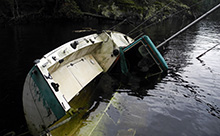Background
 Abandoned and neglected boats impact the health and safety of our shorelines, especially if fuel, chemicals or garbage are leaking into the marine environment.
Abandoned and neglected boats impact the health and safety of our shorelines, especially if fuel, chemicals or garbage are leaking into the marine environment.
If you see a boat that looks abandoned, you can help. Snap a photo, jot down the boat’s location and send these details to:
Your privacy will be protected and personal info will not be shared. The more info you can provide, the better. If possible include:
- Pictures, name, number, phone # or contact info on the boat
- General location, beached, substrate, buoy or anchored
- Length & width, type of material (wood, fiberglass, steel, cement)
Together, we can reduce this environmental and public safety risk by removing abandoned boats from our waterways and, as responsible boat owners, by preventing vessels from abandonment and degradation in the future. Boats and their components should be safely disposed of or recycled at their end of life.
Many have already been safely removed and disposed of in the region and more are currently being assessed and in the queue for federal removal funding. The success of this program is due to the amazing participation of residents.